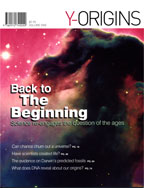LIFE IN A TEST TUBE?
In the 1950’s, Harold Urey, a professor at the University of Chicago challenged his students to create life in a test tube. One of his students who tried, Stanley Miller was jubilant, when after enormous efforts he produced a few amino acids…the building blocks of proteins.
It all appeared so promising, but what Miller didn’t understand then was that without DNA, those amino acids would never be able to form proteins…the stuff of life. The initial euphoria faded once further discoveries revealed life’s incredible complexity.
Professor J.P. Moreland compares laboratory results with the complexity required to generate life: “…if life can be likened to an encyclopedia in complexity and information, the best we have done is to synthesize a compound which carries the complexity and information of the word ME. The jump from ME to an encyclopedia is so far and speculative that the relevance of progress so far is questionable.”8
Meyer points out that the chemical codes directing the process attach themselves to the structure of the DNA molecule like letters on a chalkboard, but they do so without becoming organically involved with the board or the other letters. Therefore, he distinguishes the information content from the chemical bonding.
Furthermore, Meyer compares the sequencing of the amino acids to a language: “Amino acids alone do not make proteins, any more than letters alone make words, sentences or poetry.”9
The fact that the arrangement of the letters is not the result of chemical bonding has driven Meyer to conclude that, without intelligence, DNA would never be able to turn amino acids into proteins. He writes, “The chance of each amino acid finding the correct bond is one in twenty; the chance of one hundred amino acids hooking up to successfully make a functional protein is one in 1030.”10
And to survive, the protein chain must be contained within an intricate cellular architecture. That means that the odds against a protein being manufactured randomly are astronomical. It would be easier for a blindfolded person to find one special grain of sand hidden on one of the world’s beaches than to have a protein appear by chance.
Back | Endnotes | Next
|




